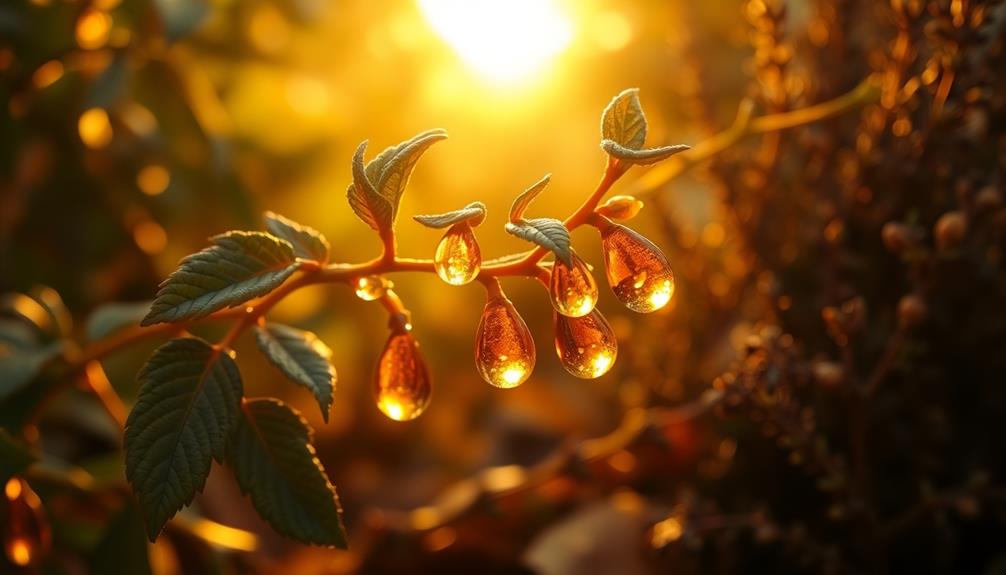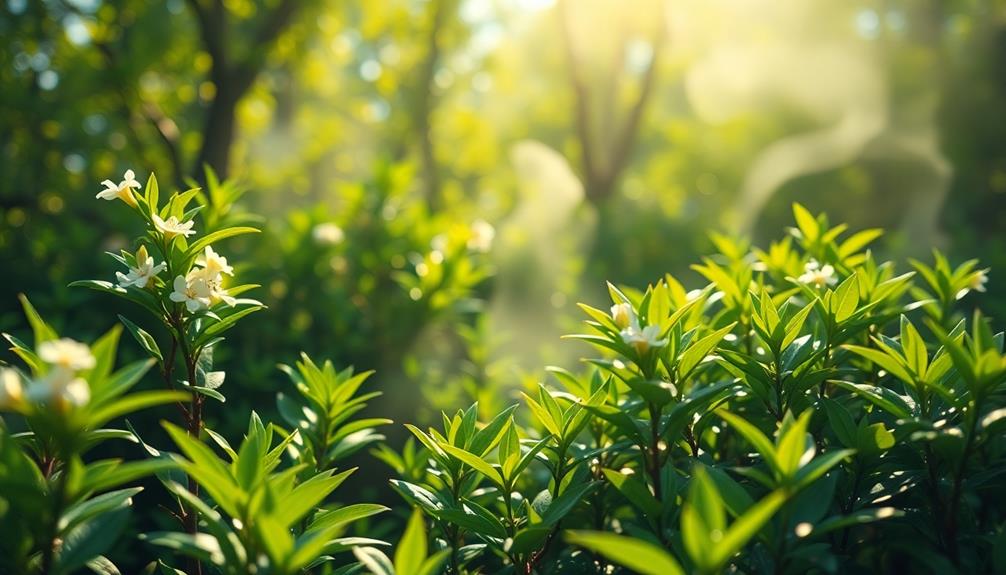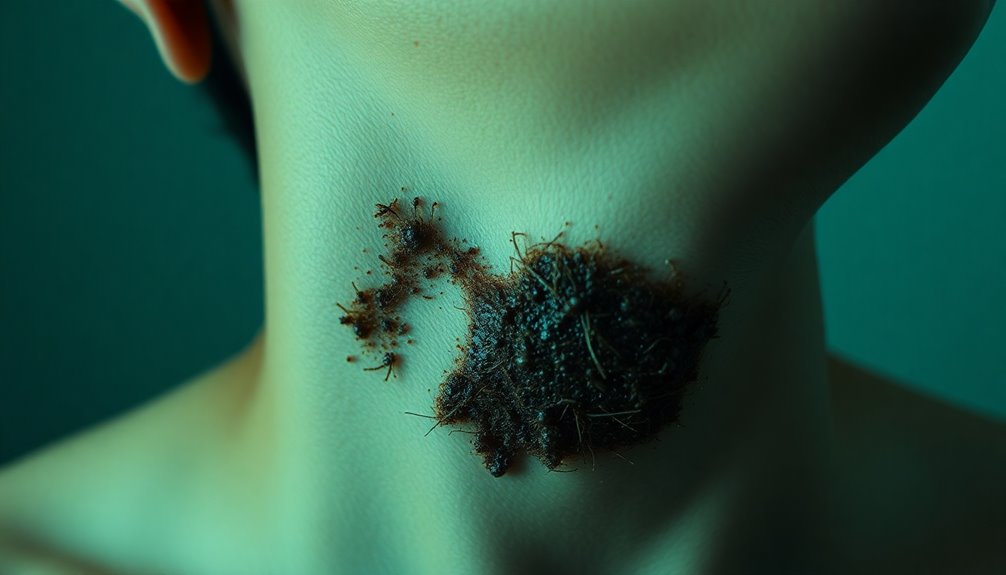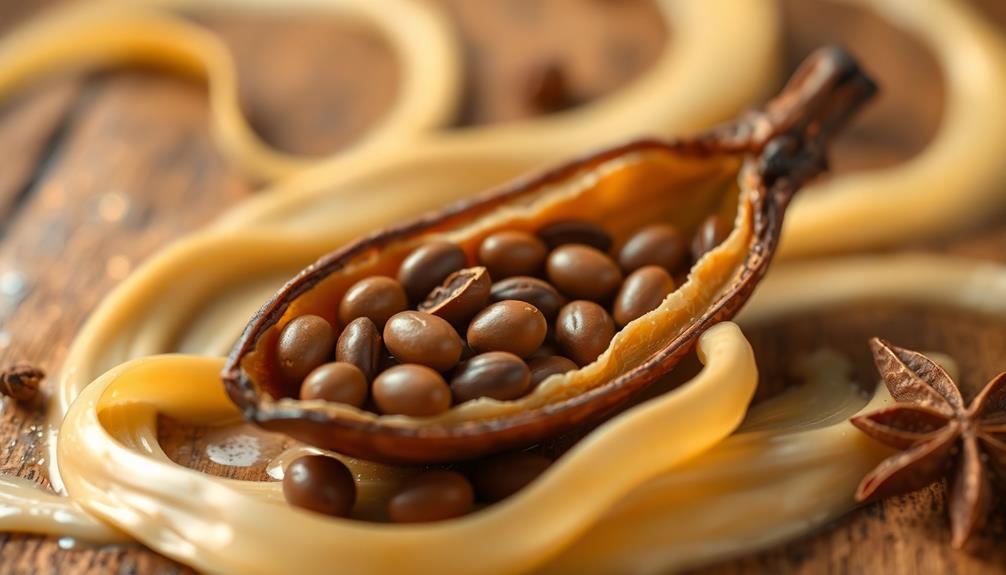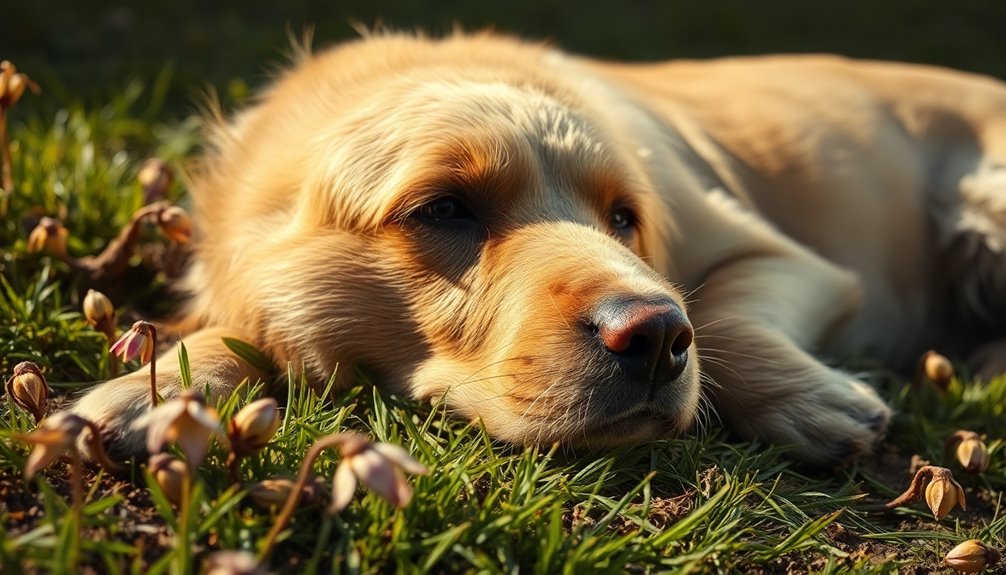Labdanum smells warm and earthy, wrapped in a sweet, musky aroma that's both inviting and rich. You'll first notice its slightly sweet notes that transition into a complex leathery scent. This unique fragrance mixes resinous and woody elements, with hints of amber, musk, and a touch of spices that add a luxurious feel. Labdanum evokes warmth and sensuality, making it a popular choice in perfumes for both men and women. Often found in cozy settings or upscale boutiques, it brings an enchanting atmosphere. Stick around to explore more about its fascinating uses and cultural significance!
Key Takeaways
- Labdanum has a warm, earthy aroma characterized by sweetness and musk, evolving into rich, leathery notes.
- Its complex scent profile combines resinous, woody elements with hints of amber, tobacco, and subtle spices.
- The fragrance transitions from slightly sweet to deep, animalic characteristics, reminiscent of ambergris.
- Labdanum serves as a valuable fixative in perfumery, enhancing longevity and depth in various scent compositions.
- It is commonly associated with intimate, cozy environments and evokes feelings of warmth and sensuality.
Introduction
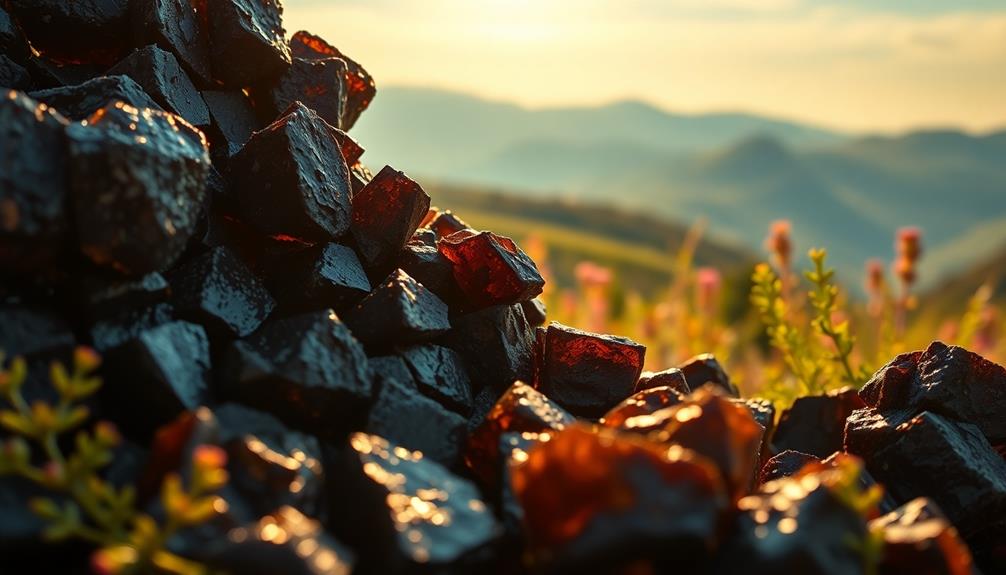
Labdanum often captivates the senses with its warm, earthy aroma that blends sweetness with a hint of musk and leather. This remarkable resin creates a unique scent experience that many find irresistible.
When you first encounter labdanum, you might notice its terpenic and pine-like notes, which then evolve into richer, more animalic characteristics. This transformation makes it a fascinating component in various fragrances.
One of labdanum's standout features is its ability to mimic the scent of ambergris. This quality adds depth and longevity to fragrance compositions, enhancing their allure.
You'll often find labdanum used in both masculine and unisex perfumes, where it elevates the overall scent profile. Its warm, slightly sweet notes combine with hints of spice, tar, and even coffee, creating a complex fragrance that evokes warmth and sensuality.
When you explore labdanum, you'll discover how versatile it's across different fragrance families. Whether you're drawn to its resinous nature or the cozy, amber-like qualities, labdanum is sure to leave you enchanted.
Description of the Smell

The captivating scent of labdanum unfolds as a warm, earthy embrace that draws you in with its sweetness and depth. As you take a whiff, you might first notice the slightly sweet notes that dance alongside a rich, leathery scent. This complex aroma combines resinous and woody elements, creating a fragrant experience that feels both intense and inviting.
You'll find hints of amber and musk that add a luxurious touch, while subtle spice notes bring an intriguing twist. At first, labdanum presents terpenic and pine-like scents, which transition into deeper, resinous layers reminiscent of tar or coffee.
There are even light tobacco hints that can emerge, adding to its allure.
Keep in mind that labdanum's unique character can introduce surprising elements. Some people describe a waxy, sour aroma, while others might detect vinegary, salty, or smoky leather notes.
These distinct facets create a fragrance that evolves, making it a fascinating scent to explore. Overall, labdanum offers a warm and earthy experience that captivates your senses, inviting you to discover its many dimensions.
Source and Composition
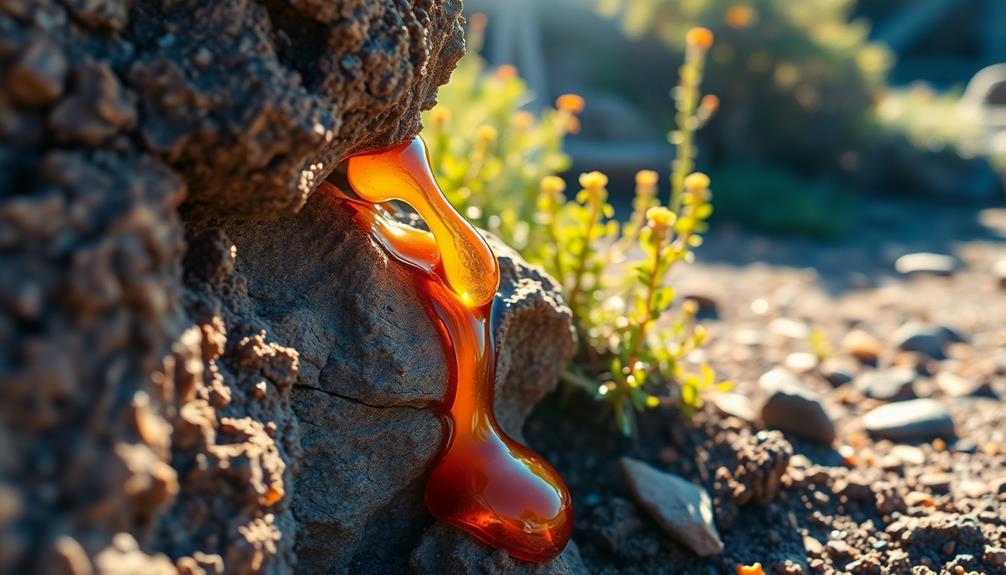
Originating from the sticky brown resin of the rockrose plant (Cistus ladanifer), labdanum thrives in the arid climates of the Mediterranean, North Africa, and the Middle East.
The process of collecting this resin is fascinating. Traditionally, people gather it from the leaves or boiled branches of the Cistus plant. Nowadays, modern methods use solvents to extract different forms, like absolute, concrete, and essential oil.
Labdanum's scent profile is warm, earthy, and slightly sweet. You'll notice leathery and animalic notes, along with hints of amber fragrance, musk, and resin.
This unique combination creates a rich aroma that can evoke a variety of scents. Sometimes, you might even catch terpenic and pine-like notes, transitioning into deeper, warmer qualities reminiscent of pepper, tar, and tobacco.
In perfumery, labdanum is a valuable fixative. It enhances the longevity and depth of other fragrance ingredients.
Its waxy and resinous aroma beautifully complements floral and spicy notes, making it an essential component in creating captivating perfumes.
Typical Scenarios or Environments
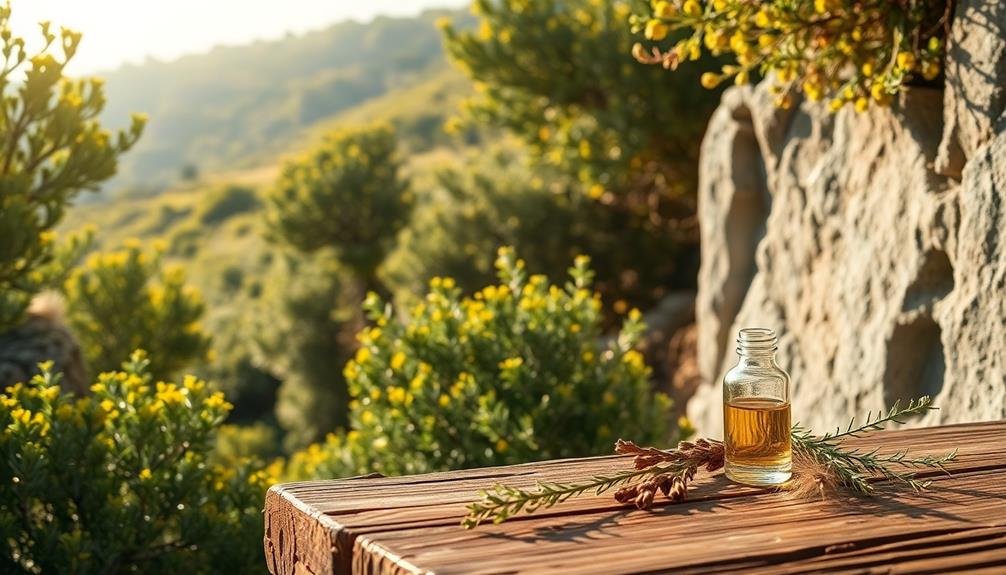
You'll often encounter labdanum in cozy, inviting environments where its warm, earthy aroma can truly shine. Imagine a candle-lit room filled with friends, the pleasant scent of labdanum wrapping around you like a soft blanket.
It's perfect for intimate gatherings or romantic date nights, where labdanum's base notes create an inviting atmosphere.
You might also find labdanum in artisanal shops or luxury boutiques, enhancing the experience with its slightly smoky and leathery qualities. This complex scent, featuring hints of pepper and coffee, makes a memorable backdrop for customers, inviting them to linger longer.
In spiritual or meditative spaces, labdanum was used in incense, providing a deep, grounding quality that helps create a serene ambiance. This makes it a great addition to mindfulness practices.
Moreover, labdanum's versatility shines through in fragrances. It can easily be a signature scent in both masculine and unisex blends, making it common in upscale men's grooming areas or modern fragrance bars.
Emotional or Cultural Associations

Labdanum's warm, earthy aroma isn't just a pleasant scent; it carries deep emotional and cultural associations that resonate across time and space. When you breathe in labdanum, you might feel comfort and sensuality, emotions often tied to ancient rituals and spiritual practices.
This resin has a rich history in Mediterranean cultures, where it symbolizes luxury and opulence, especially in the incense blends used during sacred ceremonies.
The complex scent of labdanum, reminiscent of amber and animalic notes, can trigger strong emotional responses. You may find yourself feeling nostalgic or recalling deep memories.
Its cultural significance extends to wellness too, as labdanum is often used in aromatherapy for stress relief and relaxation. This highlights its connections to well-being and holistic practices.
As a key ingredient in many traditional and modern perfumes, labdanum adds a sophisticated touch, linking you to the rich history of perfumery.
Health or Safety Considerations
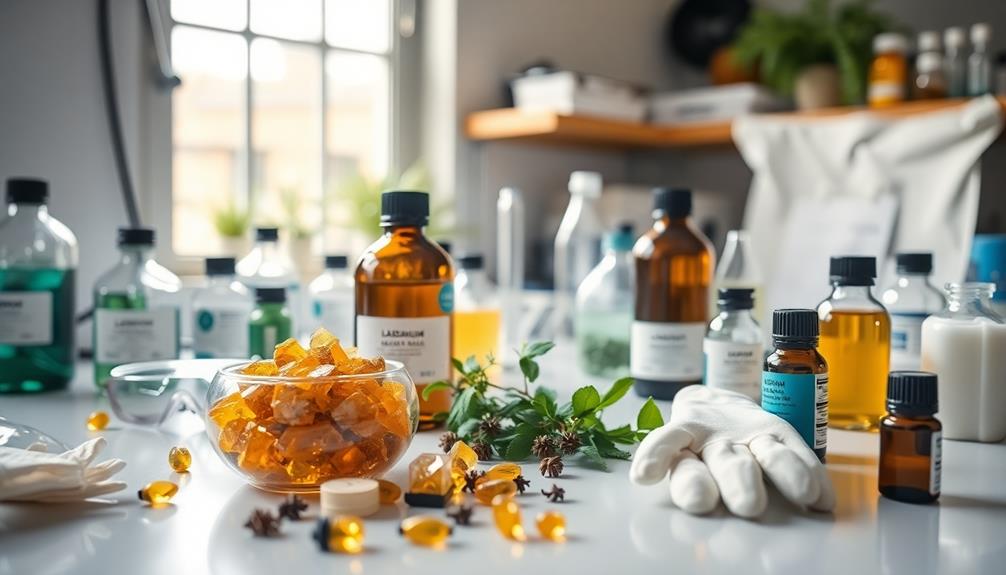
Often overlooked, health and safety considerations are crucial when using labdanum in cosmetic and personal care products. While labdanum is generally recognized as safe for topical use, it's wise to perform a patch test first. This step is especially important because, in rare cases, some people may have allergic reactions to it.
If you have sensitive skin, you should be extra careful, as labdanum could cause irritation. When using products containing labdanum, always check the ingredient list and start with a small amount. This way, you can monitor your skin's reaction.
Additionally, keep in mind that the safety regulations for labdanum can vary by region, so make sure you follow local guidelines for cosmetics and personal care items.
Labdanum is also safe for home fragrance products, like scented candles and diffusers, making it popular for creating lovely scents in your space. However, even if you're familiar with labdanum, it's important to stay alert for any adverse reactions, especially if you're trying it for the first time.
Taking these precautions will help you enjoy the benefits of labdanum while prioritizing your safety.
Final Thoughts
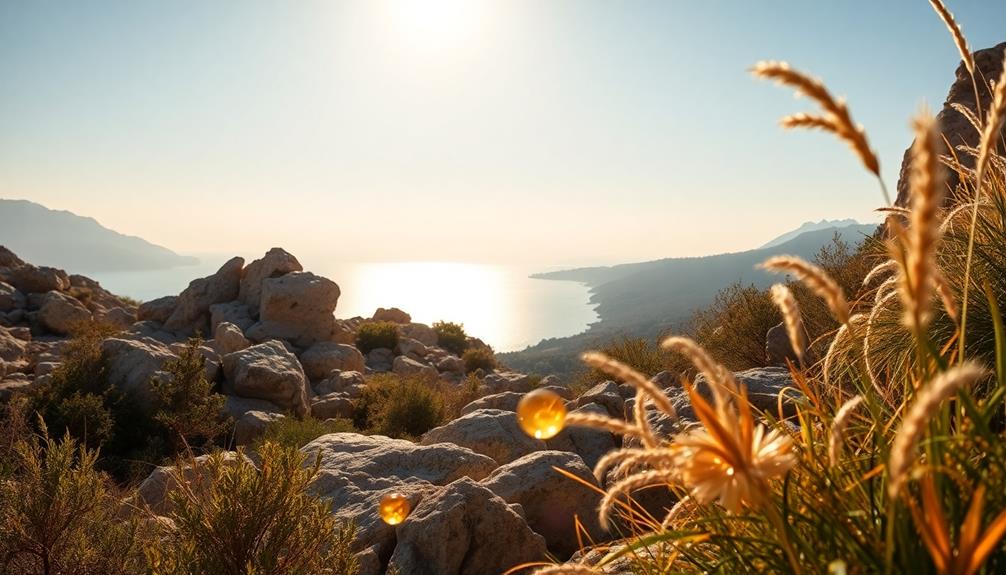
In exploring the captivating world of labdanum, you'll discover its rich and complex aroma that appeals to many fragrance enthusiasts. This warm, earthy scent brings together leathery, musky notes that remind you of amber and resin.
You might notice hints of pepper, tar, and coffee, which add depth to the fragrance, making it truly unique. Labdanum's long-lasting qualities make it a popular choice in perfume making. It acts as a fixative, ensuring that other fragrance components stick around longer on your skin.
You may find it mingling beautifully with notes of vanilla, spices, and citrus, creating balanced and inviting compositions. When you sniff labdanum, you might even visualize colors like rust and gold, as its aroma can evoke vivid imagery.
It's often compared to scents like myrrh and opoponax, adding layers of complexity. Whether you're a seasoned fragrance lover or just starting your journey, labdanum offers a delightful experience.
It adds warmth and richness to any fragrance, making it a fantastic addition to your collection. So, dive in and explore the enchanting notes of labdanum—you won't be disappointed!
Frequently Asked Questions
What Is Another Name for Labdanum?
Another name for labdanum is "ladanum." You might also hear it referred to as "gum cistus" or "black balsam." Each term highlights its resinous nature and historical significance in perfumery and herbal medicine.
Does Labdanum Smell Like Incense?
Yes, labdanum does smell like incense. You'll notice its warm, resinous aroma, reminiscent of earthy, sweet scents. Its complex notes can evoke traditional incense, giving you a rich and grounding fragrance experience. Labdanum’s deep, balsamic undertones can sometimes be compared to the dragon’s blood fragrance profile, which also exudes a mystical, resinous quality with hints of spice and amber. Together, these two scents create an atmosphere of ancient rituals and sacred spaces, offering a profoundly meditative experience. Whether used in perfumes or incense, labdanum’s similarity to the dragon’s blood fragrance profile only enhances its appeal for those seeking a grounding and spiritually evocative aroma.
What Note Is Labdanum?
Labdanum is primarily categorized as a base note in perfumery. You'll find it adds depth and longevity to fragrances, often enhancing compositions with its warm, earthy, and slightly sweet characteristics alongside other complementary notes.
What Is the Most Attractive Scent to Smell Like?
The most attractive scent for you combines warm, earthy notes with sweet undertones. You'll find that fragrances with depth and longevity, like those featuring labdanum, draw attention and evoke positive reactions wherever you go.
